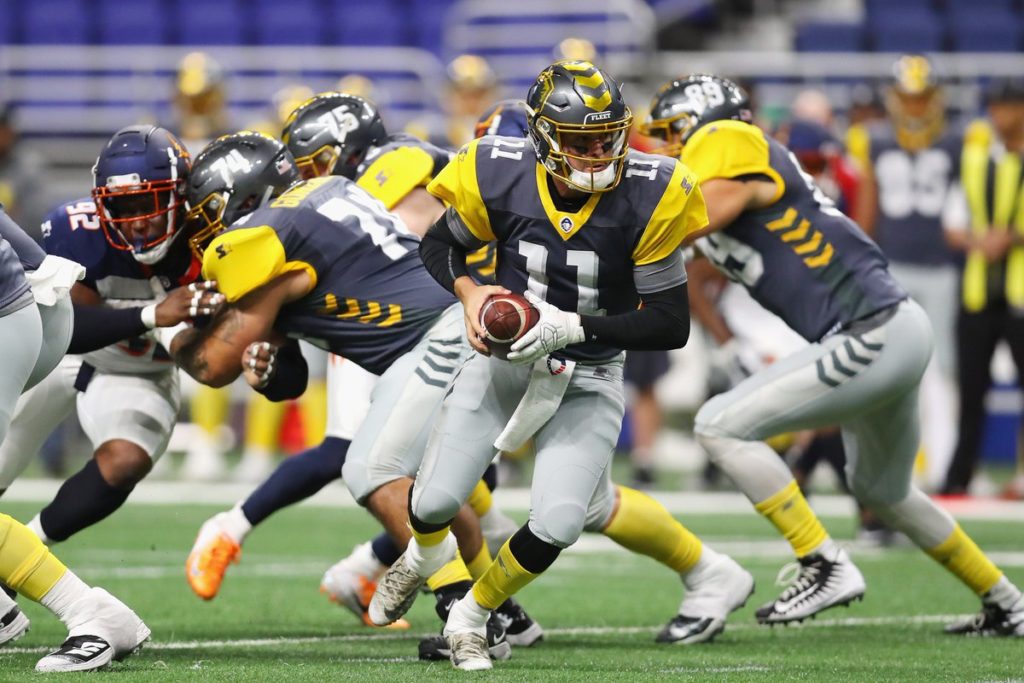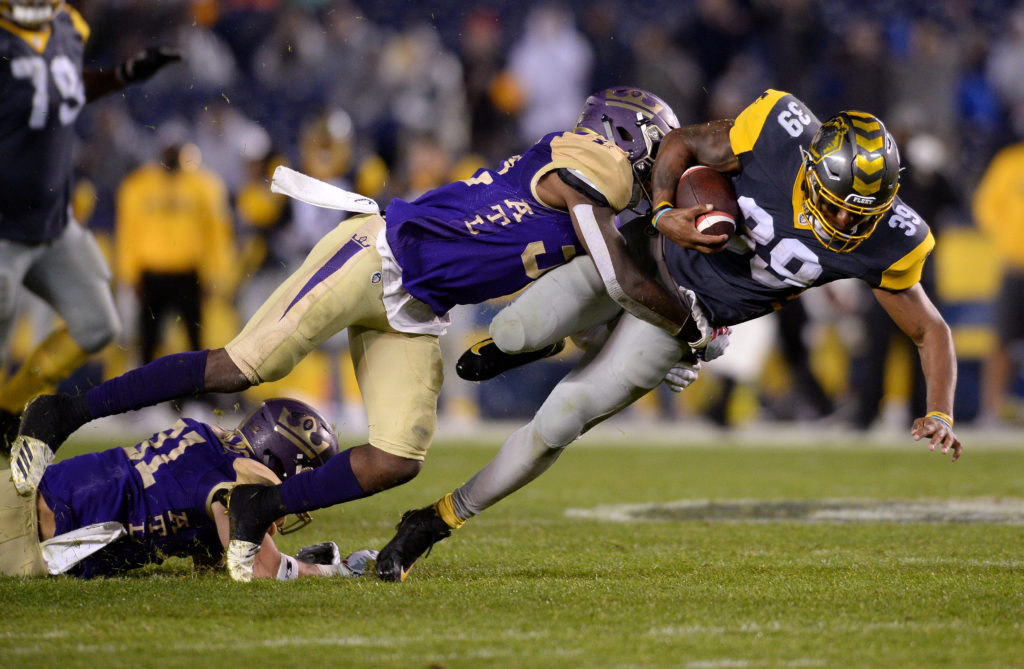Running Problems: Why Can’t the Fleet Run the Football

Credit: Fleet

Through the first three games of the season, most San Diego fans thought that the Fleet would be a dominant running team. They were averaging 162 yards a game, had the leagues leading rusher in Ja’Quan Gardner, and were coming off of
a dominant 202-yard rushing performance against the San Antonio Commanders. They were averaging an outstanding 6.16 yards a carry as a team. Then they played Memphis in week four and struggled to run the football. They still totaled 105 yards as a team, but running backs only accounted for 49 of those yards. Terrell Watson and Ja’Quan Gardner averaged 2.6 yards a carry, a big step down from their impressive 6.16 from the weeks prior.
But one bad week running the football wasn’t something to be concerned over. A team cannot be expected to run the football for over 200 yards every week, so most of the fans put the bad rushing numbers on an off day from the offensive line. But then the troubles continued. San Diego ran for only 31 yards against the Salt Lake Stallions during week five. 31 yards on 23 carries for an average of 1.3 yards a carry. Trent Richardson and his infamously low average yards per carry numbers had more rushing yards than the entirety of the San Diego Fleet with 41. This abysmal rushing performance has created questions concerning the play of this offense.
To put the Fleet’s rushing performance against the Stallions in perspective, the next lowest number for total rushing yards was 44 yards on 19 carries by the Atlanta Legends. That’s a whole 13 yards better on four fewer carries. The second lowest average yards a carry by any team in the league is the Memphis Express’s 1.8 yards a carry in week four, almost a whole half yard better than the Fleet during week five. San Diego’s rushing performance during week five was the worst in AAF history by quite a bit and is becoming a legitimate cause of concern.
But what’s happening with this San Diego running game? A team that was running the football so successfully through three weeks has now been unable to run the football. Let’s look at four plays from the last two games that highlight some of the struggles San Diego has had rushing the football.
Play One
During week four, San Diego attempted three two-point conversions, only converting one of them. They ran the ball on each of them and struggled. If they convert every single one of these two-point conversions, they win this game 27-26. However, they couldn’t. The Memphis linebackers make a great play, but our interior offensive line missed assignments as well.
This is a power play. Right Guard Beau Nunn is pulling through the hole and is supposed to be looking for anybody in the whole. He misses the linebacker scraping over the top and who eventually makes the play. I have no idea what Jeremiah Kolone and Damien Mama are doing on this play. It looks like the goal is to double team the defensive tackle before Jeremiah Kolone finds the scraping linebacker. But Damien Mama does a poor job of getting to the defensive tackles right shoulder and this allows the linebacker to rush through the gap and tackle Gardner. If Mama stays on the defensive tackles right shoulder, he would be able to adjust and at least get a hand on the linebacker that makes a play on Gardner.
Play Two
Later in that game, San Diego was in the red zone again and still wasn’t able to run the football. The Memphis linebackers seemed to know wherever San Diego was going to run the football. And while those linebackers played really well, San Diego was awfully predictable running the football. A majority of their runs involve pulling guards and man blocking concepts. While running a healthy dose of man blocking is fine, using only that makes the offense way too predictable on the ground.
On first and goal, this team runs a trap play. This play is designed to allow the defensive tackle to rush up the field and be kicked out by a pulling guard from the other side of the formation. This creates vertical separation and a hole for the running back to run through. It is blocked pretty well on the right side of the offensive line. Damien Mama should probably stay on his feet, but he successfully kicks out the defensive lineman. Kolone and Poole struggled though. Kolone gets no vertical push on the defensive tackle he is blocking and Poole, who is supposed to reach the backside linebacker, is unsuccessful. The Fleet’s offensive line has been really bad at reaching the second level and getting hands-on linebackers these past two weeks, resulting in way too many plays in the backfield by opposing linebackers.
Play Three
Against Salt Lake, San Diego was absolutely terrible on the ground. San Diego would face a seven or eight-man box that dared them to throw. They would end up running it anyways. And instead of spreading them out and running the football against a less stacked box, San Diego was intent on just pounding the rock in between the tackles into stacked boxes.
On this play, San Diego sees a seven-man box and tries to run a simple dive play with a man blocking scheme. While the play design isn’t terrible, every single linebacker and defensive lineman was expecting a run. Out of the last six two-point conversion attempts, five of them have been runs up the middle. Poole fails in kicking out the left side defensive end, which closes the hole Terrell Watson is trying to run through. It doesn’t help that Chris Gonzalez and Kolone didn’t win the double team on the defensive tackle, which allowed the linebacker to sprint in and fill the hole along with the defensive end. The Fleet offensive line has struggled to reach the second level for the past two weeks.
Play Four
There were very few good running plays against the Stallions, and even this one has it’s flaws. The thing that makes this play successful is that it’s a zone blocking scheme. Zone blocking takes away some of the problems San Diego has had reaching the second level by catching those over-aggressive linebackers “in the wash” of the play, allowing for running backs to find lanes to run through.
This play is what many call a Lead Stretch. Basically, the offensive line is blocking the guy to their left all the way to the sideline while the running back looks for a lane to run through. It is very similar to what the Los Angeles Rams of the NFL run with great success. And the Fleet have some success here. Ben Johnson should stay on his feet here when blocking a safety, but the rest of the offensive line does a great job keeping the line of scrimmage. Terry Poole does a great job reach blocking Karter Schult and Kolone does a great job fighting across the face of the defensive tackle in an attempt to reach the linebacker. The biggest problem with this play is Gonzalez, the left guard. He stays in front of his defensive tackle, but he gets pushed back two yards and disrupts Watsons ability to cut back into a wide open cut back lane.
In conclusion, San Diego has a couple of problems running the football. The first is that the offensive lineman struggle to reach the second level in man techniques, allowing the linebackers to attack the line of scrimmage and make contact in the backfield. Fixing that takes time or a switch to a more dominant zone blocking scheme. But either way, the performance of the offensive line needs to take a step in the right direction for San Diego to win more consistently.
Secondly, the ways San Diego runs the football needs to be more diverse. Lining up in the I-formation with one or two tight ends on every run becomes easily recognizable and allows the defense to fill the box and outman the offense on every run play. By running more plays out of the single back, shotgun, and spread looks you can diversify your playcalling and keep the defense on its toes. While this isn’t the biggest problem for San Diego’s rushing game, it can only help it at this point.
My names Zachary Gartin. I’m a college kid going to school in Newberg, Oregon. When I’m not writing about the San Diego Fleet, I’m usually training for football or playing Xbox. Follow me @The_Sideline10
Always hard to run against a stuffed box. The Fleet were getting better looks with Philip Nelson in at QB. Doesn’t look like the rest of the league believes Bercovici can carry the team on his back. How much do you think it will help, not just against the Iron this week, but for the rest of the year, if Bercovici has a career type game? If he goes 25-35, 350yds, 3TD, 0INTs this week, would it be enough to get defenses to play more honest?